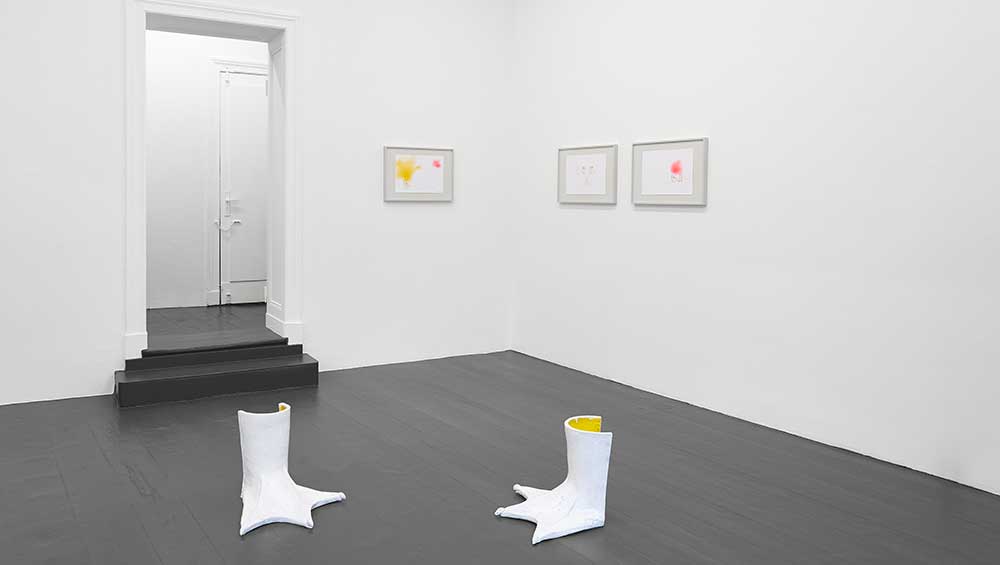
Elisa Giardina Papa, Flock – She Preferred the Lineage of Goats and Ducks, 2023, installation view, Galerie Tanja Wagner, Berlin, 2023.
Galerie Tanja Wagner, Berlin
9 September – 4 November 2023
by MAX L FELDMAN
The villagers could hear the women laughing at night. Not unkind, not furious, not an enchanter’s cruel cackle. More like giggling. Promises of secret joys, sweet escapes. Too much for normal folk doing business in a normal way, the farmers stopped and shuddered, mopping corrugated brows; the hunched and pious frowned into their repetitive tasks. The sound drifted across the hills, caught on an ebbing night wind. It mixed with those of midnight creatures – vulpine skulkers, prowling cats prancing regal through the old piazze. The steady rhythm of chirping crickets and church bells punctuated by howls of pleasure.
Flock – She Preferred the Lineage of Goats and Ducks (all works 2023) tells us the story of the donne di fora (“women from outside and beside themselves”) in early modern Sicily.* They were figures of pure ambivalence. Part witches, part fairies, they were capable of good and mischief, magic and crime, though any problems they caused could easily be repaired. Villagers would claim to have seen them at delicious, orgiastic nocturnal feasts celebrating fairy royalty, dancing hand-in-hand to the sound of the melodious lyre. At least, that is according to the Spanish Inquisition, who attempted to make their activities sound sexually depraved, fabricating a distinction between “black” and “white” magic that was never originally a part of Sicilian folklore, unlike many other places in Europe.
Sometimes, adding to the complexity, the term also refers to the people – mostly women – who accompanied the donne on their night-time excursions, blessing babies, helping the poor find buried treasure, and healing wounds caused by their counterparts. Indeed, as retribution for insulting the donne, people would find that they had grown monstrous ducks’ feet or hideous braided tails from their backsides. Sicily-born Elisa Giardina Papa tells us the story of the donne by recreating these magical maladies in sculptural form, emphasising their social role as healers doing a form of what we now call “care labour” and downplaying their sexuality, supported by poetic murals and works on paper.
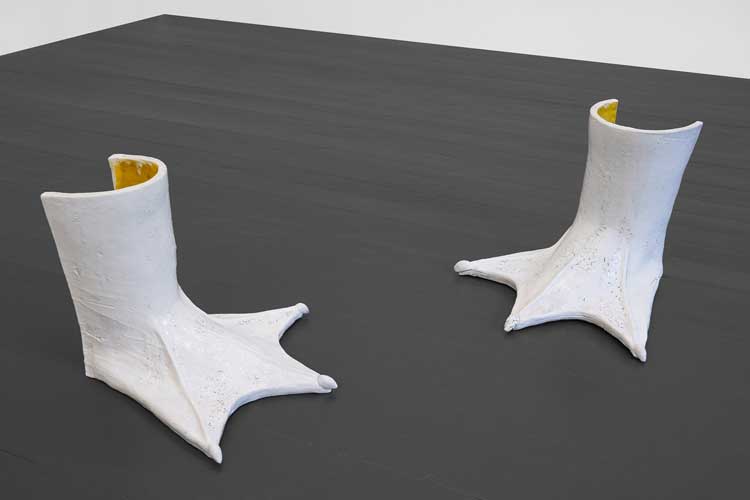
Elisa Giardina Papa. Duck Feet #1. She had a tail, thick with hair, 2023. Glazed ceramic, two piece set, each 46 x 44 x 36 cm. Image courtesy Galerie Tanja Wagner, Berlin.
Duck Feet #1. She Had a Tail, Thick With Hair is a two-piece set of wearable oversized white glazed ceramic ducks’ feet pointing towards each other, placed in the middle of the first of the three rooms that make up Tanja Wagner’s Pohlstrasse space. We see this figure again in three examples from the five-part watercolour series Heresy Begins With the Feet – the first of which shows us the transformation process from workaday human legs and feet to strange, webbed appendages – and in the video installation She Grew Paws. She Preferred the Lineage of Goats and Ducks. The latter shows us 14 different pairs of ducks’ feet, one of which we see at the end of a pair of bare human legs, while the webbed toes of the other 13 twitch subtly, rippling like the gowns of the donne as they dance in the cool night breeze.
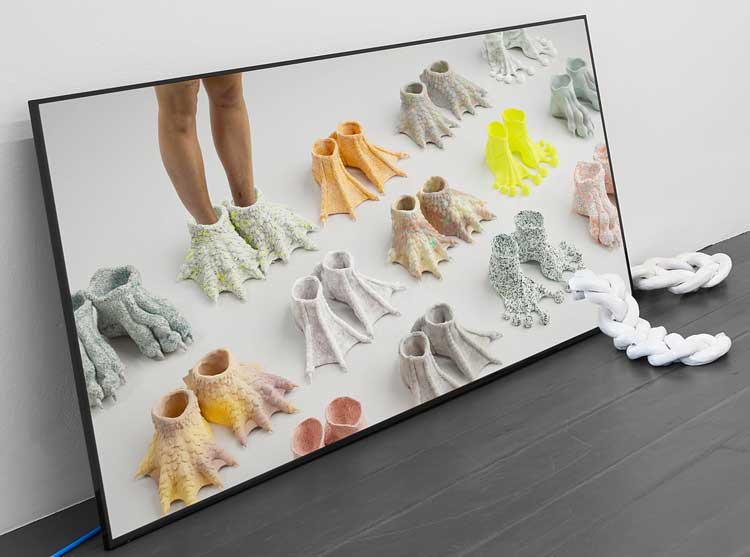
Elisa Giardina Papa. She grew paws. She preferred the lineage of goats and ducks, 2023. Single-channel 4K video installation, glazed majolica, dimensions variable. Image courtesy Galerie Tanja Wagner, Berlin.
In the third room, at the back of the space, we see three examples of the Braid series – exaggeratedly huge coiling plaits of looping, interlocking hair made, like the ducks’ feet, out of white glazed majolica. Two of these pieces are held up by an iron stand with red-orange and aquamarine-coloured embroidered straps tied around them.
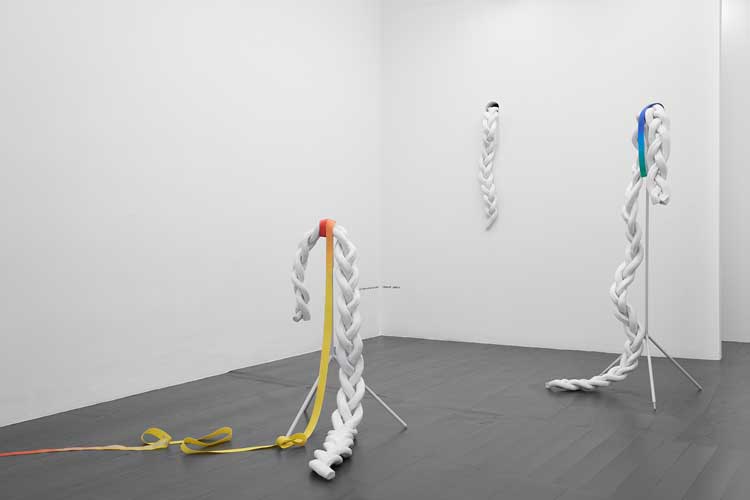
Elisa Giardina Papa, Flock – She Preferred the Lineage of Goats and Ducks, 2023, installation view, Galerie Tanja Wagner, Berlin, 2023.
Of the two stand-alone Braid sculptures (without straps), one appears to be coming from a hole in the wall that leads to the gallery’s office and another seems to pass through the screen showing She Grew Paws, just a tiny taste of the excruciating feeling of a newly developed tail poking through skin, trailing along the floor, making life humiliatingly impossible.
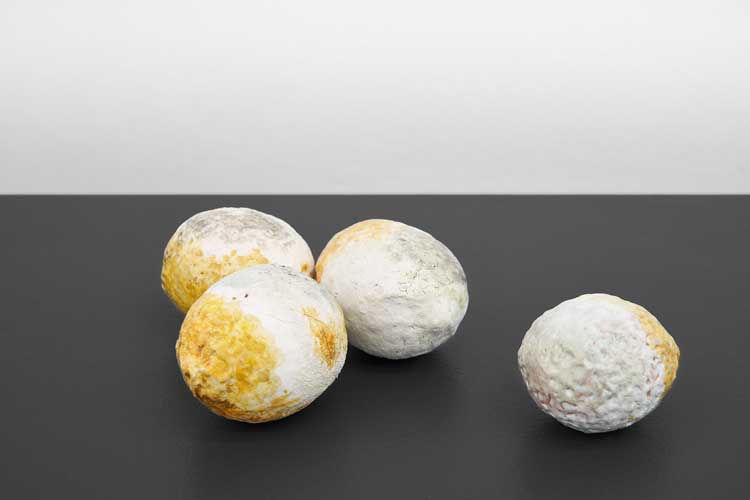
Elisa Giardina Papa. Moldy Lemons #4. They were always outside, their blasphemy was contagious, 2023. Glazed majolica, four piece set, each Ø 5 cm. Image courtesy Galerie Tanja Wagner, Berlin.
Scattered throughout the rooms, but always placed by a wall, are examples from the series Moldy Lemons. They Were Always Outside, Their Blasphemy was Contagious. And on the walls, there are the poetic murals, mostly in English but with one instance by the door to the street in Sicilian, consisting of fragments taken from a poem by the Canadian-born writer Megan Fernandes. Viewers can hear the full poem read aloud in “U Scantu”: A Disorderly Tale (2021) Giardina Papa’s contribution to the Italian Pavilion at the 2022 Venice Biennale – this piece isn’t a part of Flock, but is regularly screened and many will have seen it at Studio Mondial the week after this exhibition opened, part of the programme for Berlin Art Week festival.
Separate lines and slogans from the verses heard in “U Scantu” do, however, provide this exhibition with its title, the works their subtitles, and they appear printed on the embroidered straps tied around the Braid pieces. Of those that do not appear in the titles, we can read: “She cast spells by day and lay traps by night” (between the second and third rooms); “She could make a sardine head speak”, “She moved with one hundred orange seeds”, and “She was a thief of mother’s milk” (in the third room), and “Avia ‘na cura … e China ri pila” [“she could make a sardine head speak”] (by the front door).
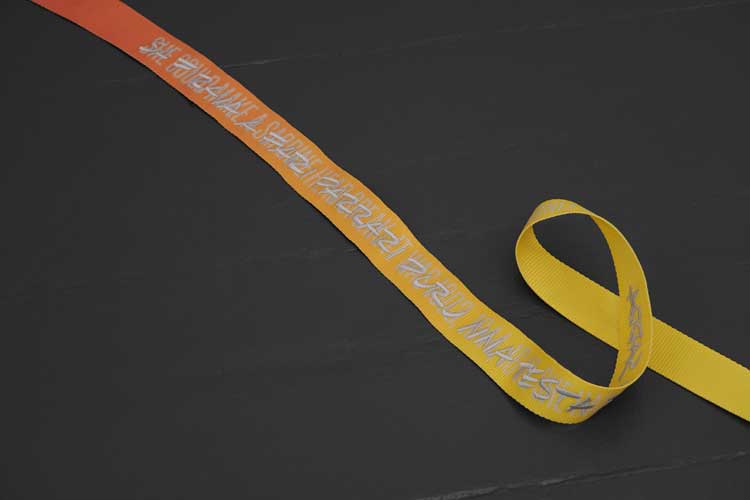
Elisa Giardina Papa. Braid #5. She could make a sardine head speak, 2023 (detail). Image courtesy Galerie Tanja Wagner, Berlin.
Giardina Papa’s use of the Fernandes poem gives us a point of entry to Flock. It contains scattered clues about how the works relate to each other, and how this exhibition relates to the artist’s work over the last eight years, including not only “U Scantu”, but the video work Technologies of Care (2016) and the installation Cleaning Emotional Data (2020), which viewers can see as part of the group exhibition Ether’s Bloom at Berlin’s Gropius Bau Museum.
The fact that Flock, the Studio Mondial screening, and these two works are all visible in different places in Berlin at the same time gives us a sense of the splintering effect the works themselves explore by making it impossible to see all of them together as a unified experience. What we then get are multiple fractures – the fragmentation of the exhibitions, the poem, overall narrative, and the body of work sharpens our appreciation of the historical experience of the donne, as their stable, predictable world was to break up with the rise of capitalism and the sort of demands it makes on the personality and our relations with others.
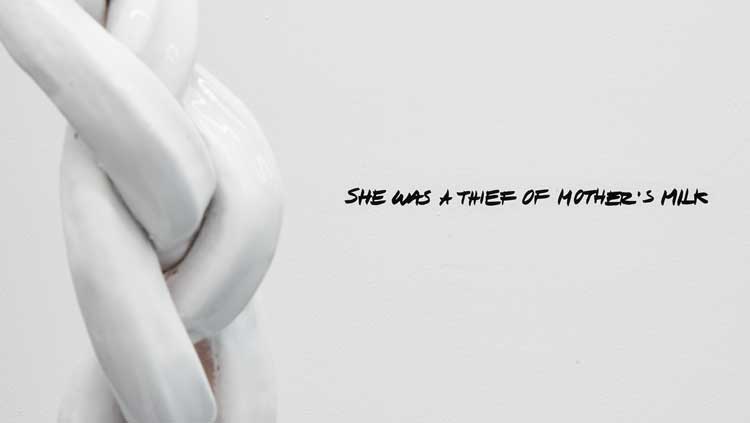
Elisa Giardina Papa, Flock – She Preferred the Lineage of Goats and Ducks, 2023, installation view, Galerie Tanja Wagner, Berlin, 2023.
By splitting the poem up into fragments that the viewer has to read for themselves on the walls or the embroidered straps tied around Braid, Giardina Papa ensures this story is always incomplete. This has the effect of partially displacing the oral storytelling tradition from which stories of the donne come – we don’t get the full narrative, but the disjointed way we read these words give us a restricted echo of how a storyteller can change the order of events or the way the tale is told, a corruption of traditional narrative expressed elsewhere in the decaying fruit in Moldy Lemons.
In the case of those embroidered straps tied around Braid, we don’t see putrefaction (real or conceptual), but have the full story withheld from us in the same way as a narrator might save the ending for another time: we can try to read the splinters of the poem from left to right, but the writing recedes beyond what we can see or read, whatever angle we take to look at the sculptures, because the strips of fabric coil around themselves or trail behind the back of them. This has the effect of reinforcing the conventions of sculpture – the two examples of Braid that have the embroidered strips remain objects of contemplation in a fixed space; picking up the straps to read the whole phrase is obviously not permitted, though this is the only way a viewer would be able to see the whole thing.
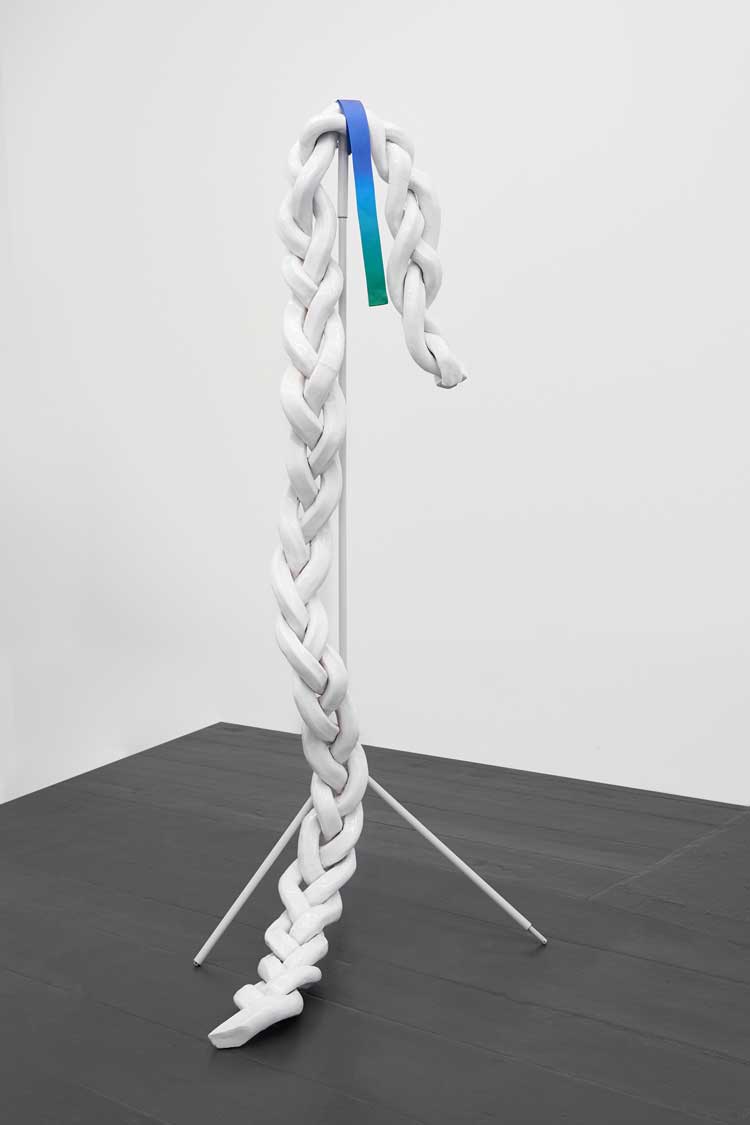
Elisa Giardina Papa, Braid #6. She was a thief of mother’s milk, 2023. Glazed majolica, iron stand, printed heavy-duty lashing strap with embroidery, 175 x 70 x 60 cm. Image courtesy Galerie Tanja Wagner, Berlin.
Similarly, it is possible to step into Duck Feet, since they have openings at the back that can accommodate human legs. An amusing picture, which we can see on the gallery’s Instagram page, shows the artist doing this herself just after the show had been installed. And this is exactly what the disembodied legs are doing in She Grew Paws. Just as we don’t get to read the whole poem on the walls or straps, meanwhile, what we see in Duck Feet, Heresy Begins With the Feet, and She Grew Paws, are just some examples of what kind of troubles the donne di fora could cause, allowing us to imagine other woes for ourselves.
The internal logic of Flock thus makes sense if we start from the poem. The murals supplant the oral tradition; this relocates feudal forms of expression into a contemporary gallery space under modern conditions where every viewer is presumably able to read and write and, due to universal literacy, writing is our dominant way of telling stories or reading poetry. Duck Feet and Braid were, meanwhile, made using the ceramic-making methods in a workshop staffed entirely by women who pass down their methods from generation to generation. This act of decontextualisation is just one example of how older artisanal or even industrial practices can be put to ends that have nothing to do with the usefulness of what gets produced (utilitarian techniques can be put to “useless” narrative ends) while still leaving the traditional methods or forms of factory organisation unchanged. The contradiction between these two sets of oppositions – oral/written poetry, industrial production/artistic display – is what gives us one of the allegorical layers of the donne di fora, which is expressed in one specific way in Flockand its relation to Giardina Papa’s recent practice.
Technologies of Care/worker 7 - bot? virtual boyfriend - excerpt, 2016.
In Technologies of Care, the artist investigates the lives of anonymous, precarious freelance workers offering digital micro-services, emotional support, peculiar requests for the worker to use their body to do something, and (presumably) sex work, outsourced by companies that allow direct contact between the service provider and client. One of these was a “virtual boyfriend”, with whom the artist had a simulated affair that lasted three months. This shadowy figure consisted of multiple people working in shifts to say emotionally revealing things (“I miss you!”, “What are you doing?”, “Are you mad at me?”) before being automated because it was cheaper. Another was an online dating coach. Another still was a video performer who provided chat services and custom videos (being hit in the face with pies made of chantilly cream, blowing balloons until they burst, showing the pores of her skin in HD video), and also wrote fairytales to encourage children to be well-behaved, though from another account. “It’s a lot of work for a few dollars,” she says.
Cleaning Emotional Data is a three-channel video installation about the same subject, in which the artist herself performs similar kinds of services to those she surveys in Technologies of Care. This time, Giardina Papa trains artificial intelligence algorithms by performing microtasks such as annotating facial expressions to animate three-dimensional characters. At the same time, however, she tells a story about the 19th-century anthropological and psychological theories that shape how the digital models recognise what counts as a real emotion. Machines thus read and process human emotions in terms derived in part from allegedly “scientific” 19th-century theories of race and delinquency, leading to situations in which the artist produced the “wrong” emotion when she was meant to be displaying happiness or sadness.
“U Scantu” is directly tied to Flock. It reimagines the myth of the donne di fora as teenage “tuners” who ride around cities – in this case, the abandoned postmodern architecture of Gibellina Nuova, a town built from nothing in the Sicilian province of Trapani after the 1968 earthquake destroyed most of the settlements there – on custom-built bikes armed with huge boomboxes. This is accompanied by readings from Fernandes’s poem, 19th-century Sicilian fairytales, the artist’s childhood memories of songs sung, and stories told, by her grandmother, and archival materials from the interrogations of the donne by the Spanish Inquisition, once it eventually caught up with them.
The point in both Technologies of Care and Cleaning Emotional Data is that all these types of work are hugely intensified examples of what the Italian sociologist Maurizio Lazzarato calls “immaterial labour”. This refers to the way we train ourselves to sell not just our personalities, ideas, or attention, but our facial expressions and skin, as the logic of the system requires not just what we do with our time when we are at work, but “command over subjectivity itself; the prescription and definition of tasks transforms into a prescription of subjectivities”.1
Where “U Scantu” updates the myth of the donne, Flock considers its original context in relation to the conditions of immaterial labour she explores in Technologies of Care and Cleaning Emotional Data. The focus in Flock is clearly on the rich experience of the donne, whose abilities as healers were respected as part of the natural order of things and whose whole personalities were a part of what they did, compared with the shimmering pool of replaceable labour that make online services possible. Even if this isn’t the exclusive focus of Technologies of Care, it is increasingly clear to anyone who uses the internet – and this is surely all of us – that vast amounts of this involves providing online sexual services, updating the way the Inquisition made the donne sound like sexual deviants under different conditions of personal choice and exploitation.
Online sex work seems to rely on the exquisitely careful rationalisation of the client’s desire: one person watches another move silkily on screen, but both parties are more interested in the vellicating effects produced by the movement of single body parts – feet, breasts, abdominal and other muscles, sexual organs – which can be calculated precisely in terms of how many people are watching or how much money is made. If there is any truth in the idea that the donne enjoyed wild, joyous group sex, however, it would have been under different economic conditions where the body was not yet fractured (in sex or any other activity) by the division of labour. Even in the post-Inquisition fantasy version, they were probably imagining a scene in which whole bodies were voluptuously mixed up with each other during magnificent feasts. Not the detached simulated intimacy of the disposable virtual girlfriend or boyfriend who just repeats stock phrases and cliches that the buyer may well be able to predict (so unlike Fernandes’s poem), that is, but total sexual abandon in the explicit version and, as Giardina Papa really wants to emphasise, real gentle soothing care to put things right after the donne had played their prankish punishments.
The donne are, of course, not just ambivalent figures, but part of a transitional age: the shift from feudalism to capitalist modernity. Their very existence and the things they are supposed to have done were constructed as much by the stories of poor but emotionally inventive local villagers as by the trial reports of the grim-faced functionaries of the Spanish Inquisition. Even if Sicily is still an economic backwater and traditional norms continue to play a significant role in social life there, Giardina Papa’s point is surely that women like them were about to have their lives upended and their personalities fragmented by the social and economic changes brought about by the rise of capitalism.
Hence the full allegorical significance of the donne: they did an early version of what would become immaterial labour by healing people under feudal conditions (explicit domination, reciprocal obligation, the stifling confines of village life) which had, however, still not yet devalued women’s labour by turning them into baby-making machines for the sake of creating future workers.2 Following Giardina Papa’s investigation, the donne appear as an exemplary expression of the kind of emotional and care labour that can now be delivered as a micro-service, but hollowed of real interaction and meaning. The difference is that this takes place under conditions that have been intensively reorganised in the digital age (nomadic entrepreneurialism, precarity, hyper-exploitability), which maintains and commodifies a simulated version of the donne as immaterial labour.
According to the 115 surviving trial summaries submitted by the Sicilian tribunal to the Suprema, the Inquisition Council at Madrid, 3,188 people were tried for heresy between the years 1579 and 1651. Among them were 456 people accused of being sorcerers, diviners, astrologers and necromancers. And among them were the donne di fora. At least 65 people (57 women and eight men, all poor) were tried, sometimes tortured, and banished or imprisoned for these crimes against Catholic orthodoxy. Some of the men were condemned to galleys, the women to being whipped.The Inquisitors record how poor the accused were. These were farm-labourers, workmen and fishermen, and their wives; a tailor, a shoemaker, a deacon, two Franciscan begging nuns, a washerwoman, two prostitutes, two “gypsy” women, seven widows. They were harmless dreamers, perhaps with healthy sexual appetites, dancing splendorous in dreams that they could never make real; skilled in healing, in soothing, rich not with material things, but with knowledge of the people they pranked and treated, living together under intolerable conditions.
The world of the donne di fora is long gone. Even if we don’t think there’s a correlation between technological and general human moral progress, it should go without saying that we have gained much. We have cured diseases worse than ducks’ feet and tails and improved the human lot beyond anything that could have been imagined when the donne roamed the scrubby hillsides of Sicily. But we have little time for magic or fancy like this. Nevertheless, the donne di fora myth still plays a part in Sicilian culture; a magical superstition surviving alongside conventional forms of Catholic piety; a brilliant product of the feudal peasant imagination carrying on in a still-underdeveloped part of a society dominated by modern economic rationality just like anywhere else. And yet we still live among them in semblances, in whispers.
* There are some minor linguistic difficulties here. These characters are only called donne di fora in modern Italian; in Sicilian dialect, they are known as donni di locu or donni di notte. Sicily was, however, a part of the Spanish empire from 1282-1713, and in Spanish they are known as the doñas de fuera. The artist, however, refers to donne di fora in all the documentation about these works.
References
1. Immaterial Labour by Maurizio Lazzarato, translated by Paul Colilli and Ed Emory. In: Radical Thought in Italy: A Potential Politics, edited by Paolo Virno and Michael Hardt, published by University of Minnesota Press, 1996, page 135.
2. Caliban and the Witch: Women, the Body, and Primitive Accumulation by Silvia Federici (1985/2004), published by Penguin, 2021, chapter 2 (The Accumulation of Labour and the Degradation of Women).